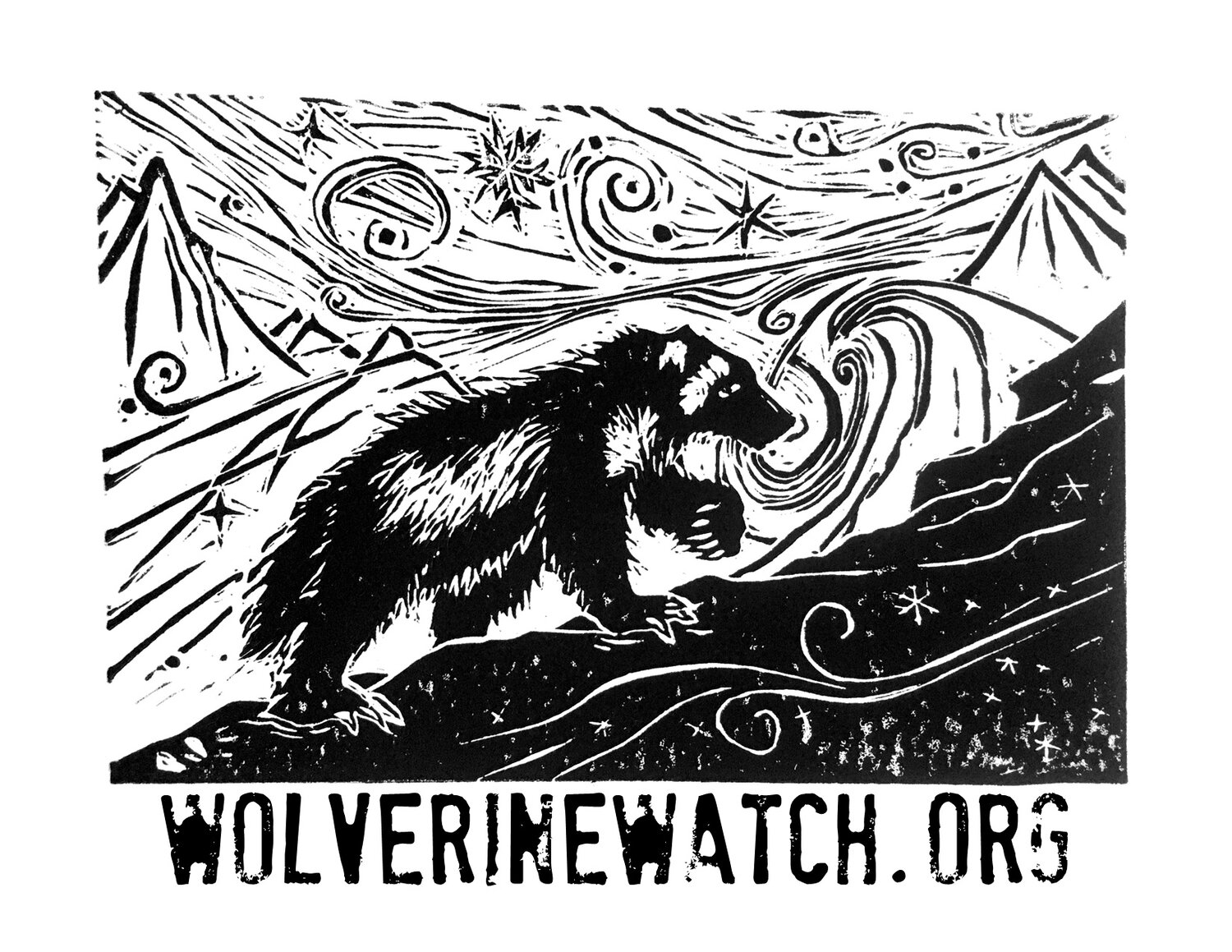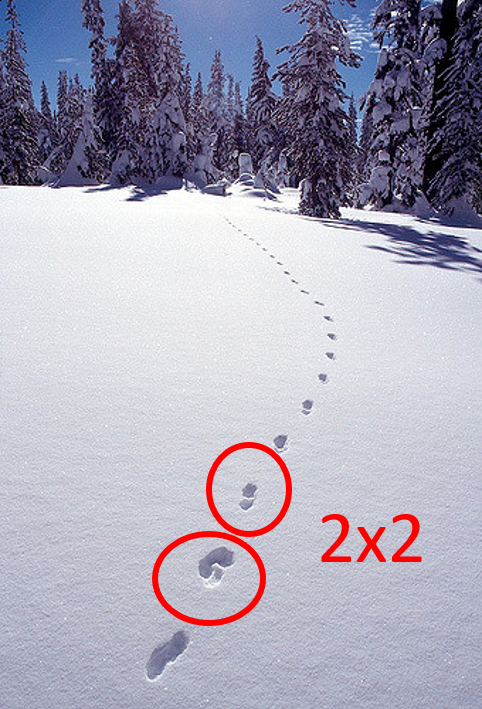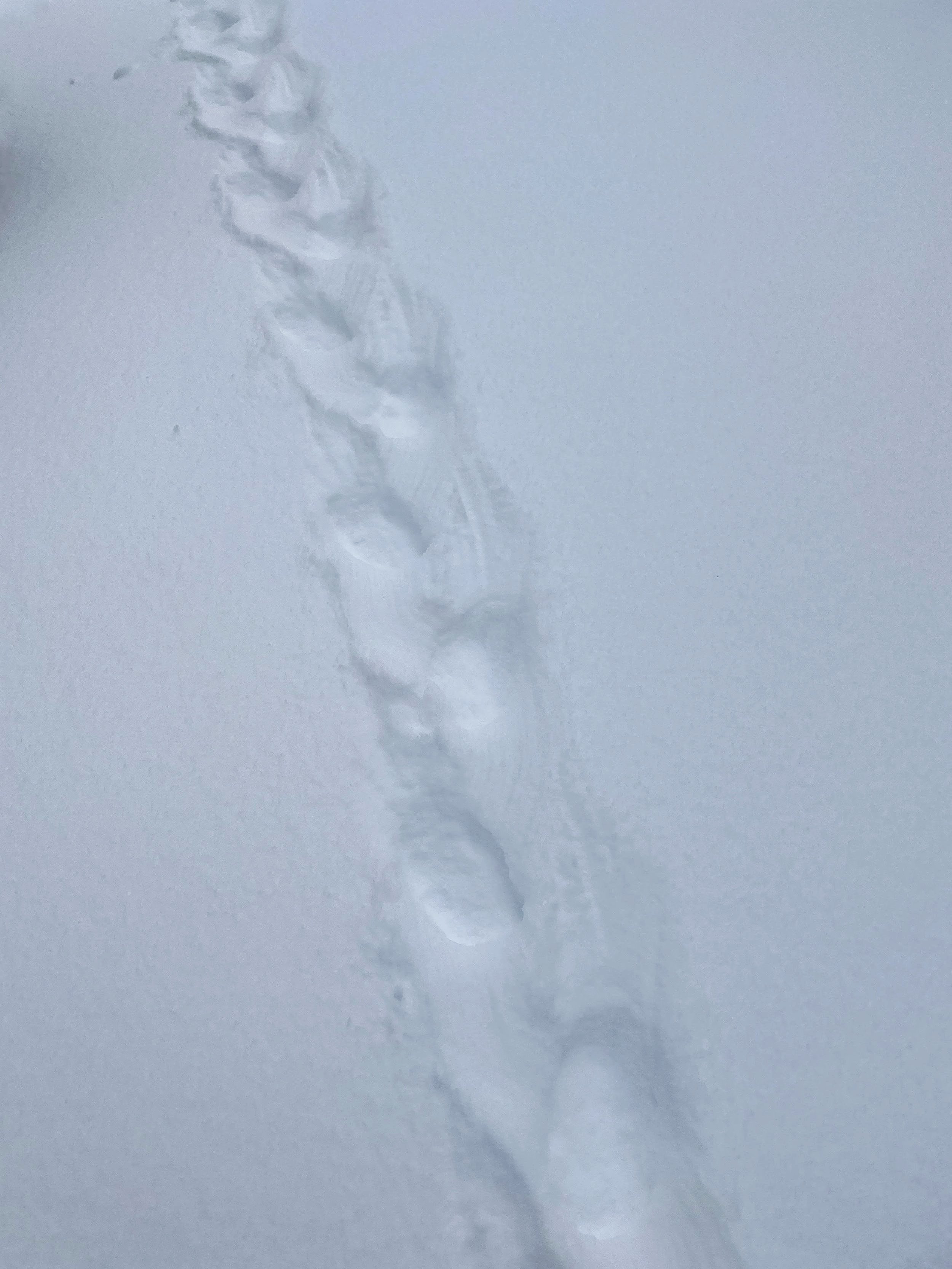How to identify wolverines and their tracks
We receive lots of wolverine (track) observations, but also many observations of other animals that are mistaken for wolverine.
Marmots and porcupines are the animals most often mistaken for wolverines.
Marmot tracks and marten tracks are the tracks most often mistaken for wolverine tracks.
Porcupine dens are frequently reported as wolverine dens - we have been fooled before, too.
Click on the animal images to see submitted photos of the different species (in progress - not yet active for all species).
Then further down we give tips on how to identify their tracks.
1. Wolverine (Gulo gulo)
2. Pine marten (Martes americana)
3. Canada lynx (Lynx canadensis)
4. Porcupine (Erethizon dorsatum)
5. Hoary marmot (Marmota caligata)
1. Wolverine
Wolverines are about 0.6 – 1.0 m (2.0 to 3.3 feet) long (including the bushy tail).
Their paws are large: 10 - 12 cm long (4 - 4.7 in) and 8 - 10 cm (3 - 4 in) wide!
Wolverines have 5 toes on their paws, just like bears!
Canines (dog family: wolf, coyote, fox, dog) and felines (cat family: lynx, cougar/mountain lion, bobcat) show only 4 toes.
Wolverine tracks display a characteristic 2×2 pattern when they walk, and a 3×3 pattern when they run.
Wolverine tracks are also found in the valley bottom and in forests but are most easily seen above tree-line.
Wolverines usually travel in a straight line, sometimes for kilometers, as if they are on a mission!
Wolverine tracks 2x2 gait (walking)
When traveling slowly, wolverine tracks often have a characteristic 2x2 pattern. When the snow is deep, one cannot see the paw prints.
Wolverine tracks 3x3 lope (running)
When wolverines move fast, their tracks show this 3x3 loping pattern. Notice that when the snow is shallow (upper image), one can see the toes and pad prints, but not when the snow is deep (lower image).
Wolverine paws are hand-sized.
Wolverine paw prints are large: 10-12 cm long (4-4.7 in) and 8-10 cm (3-4 in) wide! These prints in shallow snow clearly show the 5 toes with claws. The 5th toe is usually, but not always, visible.
Wolverine ID Card
2. American (pine) marten
Marten are much smaller than wolverine.
Marten tracks are half the size of wolverine tracks.
Like wolverines and other mustelids (weasels) they make 2×2 or 3x3 track patterns.
A marten only measures about 0.5 – 0.7 m (1.5 to 2.2 feet) (including their long tail).
Marten paws are small, 3.5 – 4 cm long (~1.5 inch).
Marten tracks - 2x2 pattern
Marten tracks can look like mini-wolverine tracks, but they are much closer together and much smaller.
Marten (left) and wolverine (right)
Different sizes: snowed-in marten tracks on the left, snowed-in wolverine tracks on the right, both with a 2x2 pattern.
Wolverine (left) and marten(right)
Wolverine (left) and marten (right) tracks in fresh snow: the size difference is obvious when they’re next to each other. Photo credit: Morgan Megarry.
Marten tracks - 3x3 pattern
Without a size reference, these 3x3 marten tracks look a bit like wolverine tracks. Remember: a wolverine paw is 8-10 cm (3-4 in) across!
3. Canada lynx
Lynx tracks are of a similar size to those of wolverines.
Lynx do not show a 5th toe.
Claws are, like with all cats, retracted when they walk.
Lynx walk in a more undulating way than wolverine,
The distance between lynx prints is very regular (no 2x2 or 3x3 pattern like wolverine).
Lynx tracks deep snow
Lynx usually walk in an undulating line. Their paw prints are regularly spaced.
Snowed-in lynx tracks
A snowed-in lynx track. Note the regular spacing, unlike wolverine.
Lynx have 4 toes not 5 like wolverine
Lynx prints only have 4 toes (not 5 like wolverine) and no claws.
Evenly spaced lynx paw prints
Lynx generally walk with evenly spaced paw prints, they don’t run like wolverine.
4. Porcupine
Porcupine are rodents that can be mistaken for wolverine (link to porcupine video)!
They have a very characteristic, undulating gait (manner of walking), and usually drag their tails.
In deep snow, porcupines can leave hard-to-identify tracks that look like trenches.
We often get reports of “wolverine dens”, which then turn out to be porcupine tracks & dens. We ourselves have been fooled, before, too! click here to see what wolverine and porcupine dens look like!
Porcupine tracks deep snow
Porcupine tracks in the alpine are sometimes confused with wolverine tracks. Note the oddly looking undulating pattern.
Porcupine tracks wavy pattern
Porcupine tracks in deeper snow, note the undulating steps, and the wave caused by the tail that is dragged behind.
Porcupine trails from tree to tree
Porcupine tracks form a network of trails between trees. Photo Credit: Parks Canada
Porcupine tracks shallow snow
Porcupine tracks in shallow snow. Note the slightly duck-footed, regular pattern. Some drag marks.
5. Hoary marmot
Coming soon
If you're still having trouble distinguishing if the track is that of a wolverine, this video is an excellent resource.






















